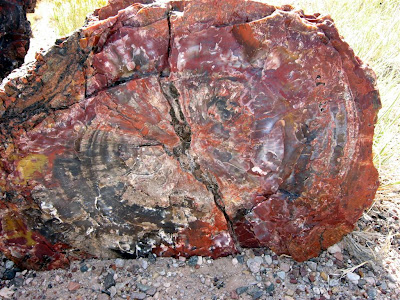
From the entrance of the park to the Visitor Center is over 15 miles, but it takes quite a while to drive it, because you keep stopping to admire the magnificent views and to snap pictures (lots of pictures).
The largest and most often photographed site in the park is the Cliff Palace, which can be experienced up close by taking one of the ranger-guided tours. This is looking down upon the Cliff Palace from the overlook at the start of the tour. Tours are conducted every half hour. The 60 spaces on each tour usually fill quickly.

The ancient dwellers in this area moved here around 700 a.d, and remained until 1200-1300 a.d., when they migrated to other areas of Arizona and New Mexico. No one knows why they left Mesa Verde, although a severe drought during that time probably contributed to their hunting a new homeland. Many of the present day pueblo residents are descendant from these ancient tribes.

Our tour was one of the first of the morning. It began by descending a narrow trail along the edge of the cliff.
From the trail, we could look across at another ruin.


This is a zoomed view of that ruin.
Round, below ground rooms, in the dwellings are known as kivas.

Kiva is a Hopi word meaning ceremonial room. It is believed the ancient dwellers used their kivas both as a place of worship, and as a "family room" of sorts, a cozy place to keep warm in the winter, or cool in the summer. A single family dwelling usually contains 1 kiva.
There are many kivas in the Cliff Palace, leading experts to speculate that perhaps it was not a dwelling, but a meeting place for the families in the area. The palace consists of many rooms.
The trail from the ruin to the top is very narrow between the rock walls, and terminates with a wooden ladder, similar to those the natives would have used between structure levels.
We also hiked to the Spruce Tree House, the best preserved ruin in the park. It contained 129 rooms, and probably was home to 60-90 people. A ranger is stationed there to answer questions. At this site, we were allowed to descend into a kiva. For photos from our day at Mesa Verde, click below. As you look at scenes of the cliffs, see how many cliff dwellings you can spot. There are 600 of them in the park, and a total of 4500 archaeological sites - simply amazing. It seems you can pick them out in every crevice between the rocks. Only the sheltering rock ledges have allowed them to be preserved so well throughout the centuries.



 Oatman was a gold mining community, and has been preserved much as it was in its heyday. It's biggest tourist draw today is its wild burros.
Oatman was a gold mining community, and has been preserved much as it was in its heyday. It's biggest tourist draw today is its wild burros.














































